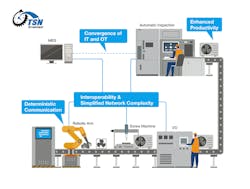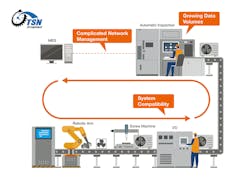Time-Sensitive Networking: The Benefits, the Challenges, and How to Integrate Successfully
Imagine a factory floor where machines communicate with each other with such precision that even a millisecond of delay can lead to costly downtime. How can we prevent a scenario like this and ensure the timely and accurate data transmission? What if an advanced Ethernet technology, prioritizing every millisecond, galvanized a complete shift in industrial automation?
This is the promise of time-sensitive networking (TSN), a cutting-edge technology that is on its way to changing industrial automation. The numbers don't lie: analysts project that the global TSN market will grow by a staggering 58.3% annually, reaching a value of USD 1.7 billion by 2028, according to a MarketsandMarkets report.
In this article, we will explore what's driving the rise of TSN, how it's reshaping industrial efficiency, the challenges when deploying this technology, and how to tackle them.
5 Benefits of Adopting TSN
TSN's transformative power is evident, for example, in a major home appliance manufacturer, resulting in significant improvements across several key areas:
1. Deterministic Communication
The low-latency, deterministic traffic scheduling of TSN allowed for precise control and synchronization of production line devices. This enhanced real-time control and overall system responsiveness, crucial for maintaining high performance in data-intensive environments.
2. Interoperability
TSN enabled an integration of diverse production equipment from different vendors, simplifying network management and optimization. This streamlined network management and optimization ensured consistent compatibility and performance throughout the production line.
3. Convergence of IT and OT
By unifying IT and OT systems on a single network, TSN streamlined operations, reduced overhead, and enabled faster decision-making.
4. Simplified Network Complexity
TSN consolidated network communications into a single, simplified architecture based on standard Ethernet, reducing complexity and costs while allowing for easy scalability.
5. Enhanced Productivity
TSN's ability to prioritize control data and ensure timely transmission enhanced productivity for the manufacturer, resulting in reduced downtime, faster response times, and increased equipment effectiveness.
The cumulative effect of these enhancements resulted in improved operational efficiency, higher productivity, and substantial progress toward the manufacturer's goals for efficiency and precision.
3 Possible Challenges of Adopting TSN Technology
4 Tips for Successful TSN Integration
It's important to recognize that TSN integration involves complexities. As mentioned before, the benefits—including improved real-time control, seamless interoperability, and converged network architectures—are substantial, but there are also challenges to address.
To ensure a successful deployment, organizations must consider multiple critical aspects:
1. Choose TSN Solutions With Full Gigabit Performance
As data demands increase in industrial environments, efficient handling of higher data volumes necessitates high-bandwidth capabilities. Therefore, it's important to choose TSN solutions that support full Gigabit speeds on each port to ensure robust network performance.


